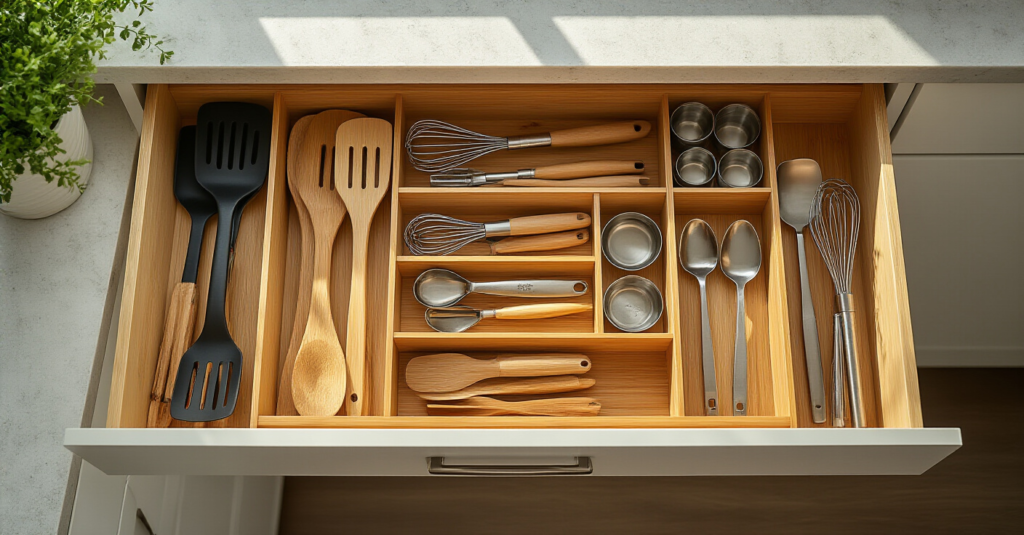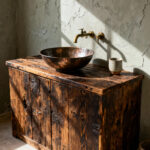Picture this: You’re standing at your open kitchen door, looking out at the patio. The grill is ready, drinks are cold, and your friends are just starting to relax in the evening light. You step back inside to grab the salad and the tongs. And that’s where the flow stops. You can’t find the salad bowl because it’s stuck behind a stack of mismatched containers, and the tongs are buried in a drawer that looks like a metal birds’ nest. By the time you get back outside, the perfect moment has been cluttered up with frustration.
That’s the friction I see all the time. People design these beautiful outdoor living spaces, but the kitchen—the engine room for all that al fresco joy—is working against them. A disorganized kitchen is like a dam in a river. It stops the natural flow between inside and out. It’s not just about finding the paprika faster; it’s about making your entire home feel more connected, more livable, and more ready for life to happen.
Forget the sterile, magazine-perfect kitchens you see online. Nobody actually lives like that. The real goal is to create a space that functions like a healthy ecosystem—everything has its place, everything has a purpose, and it all works together seamlessly. We’re going to get rid of the stuff that’s just noise and focus on what actually makes your day-to-day life easier, whether you’re making coffee for yourself or carrying platters out to the garden.
Laying the Foundation: Assess & Declutter for Ultimate Efficiency
Before you buy a single organizer, you have to clear the ground. You can’t plant a beautiful garden on a patch of weeds, and you can’t organize a kitchen that’s overflowing with stuff you don’t need. This first phase is all about ruthless editing. It’s about creating a clean slate so you can build a system that actually supports the way you want to live.
1. Audit Your Utensil Drawer: Remove Duplicates for 30% More Space
That main utensil drawer is almost always ground zero for clutter. It’s the place where good intentions—and five nearly identical spatulas—go to die. When I say audit the drawer, I mean dump the entire thing out on the counter. Every last whisk, spoon, and weird gadget you got as a stocking stuffer five years ago. This isn’t just tidying; it’s an archeological dig.
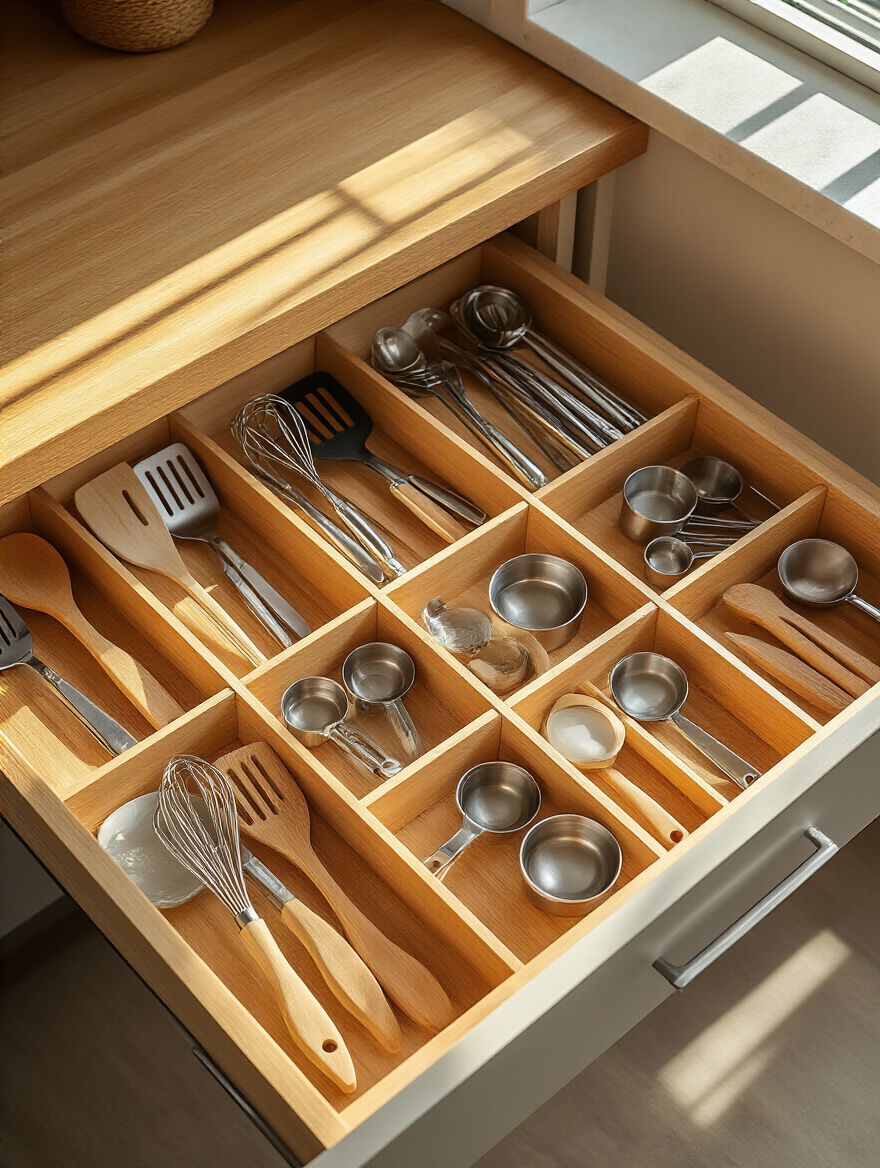
You’re going to be shocked at what you find. Six can openers? Four whisks? We all have them. The common sense advice is to just get rid of duplicates, but here’s what actually matters: keep the one you instinctively reach for. Keep the one that feels right in your hand. The rest is just clutter taking up prime real estate. I once had a client who freed up an entire drawer by doing this, creating space for the grilling tools that were always cluttering up his counter. It’s about making space for what you actually use.
Now that you’ve gotten honest with yourself about what stays, you can give everything a proper home. Get some simple, adjustable dividers. Think of it like creating channels for water to flow—each utensil has its designated path, so it never gets jammed up with the others.
2. Declutter Pantry Shelves: Donate Unused Items to Prevent Waste
Your pantry is a living thing. And if you’re not careful, it can get overgrown with things you’ll never use. That can of artichoke hearts from 2019? The three nearly-empty boxes of a cereal your kids decided they hate? It’s not just clutter; it’s wasted money and food. You have to be the gardener here and pull the weeds.
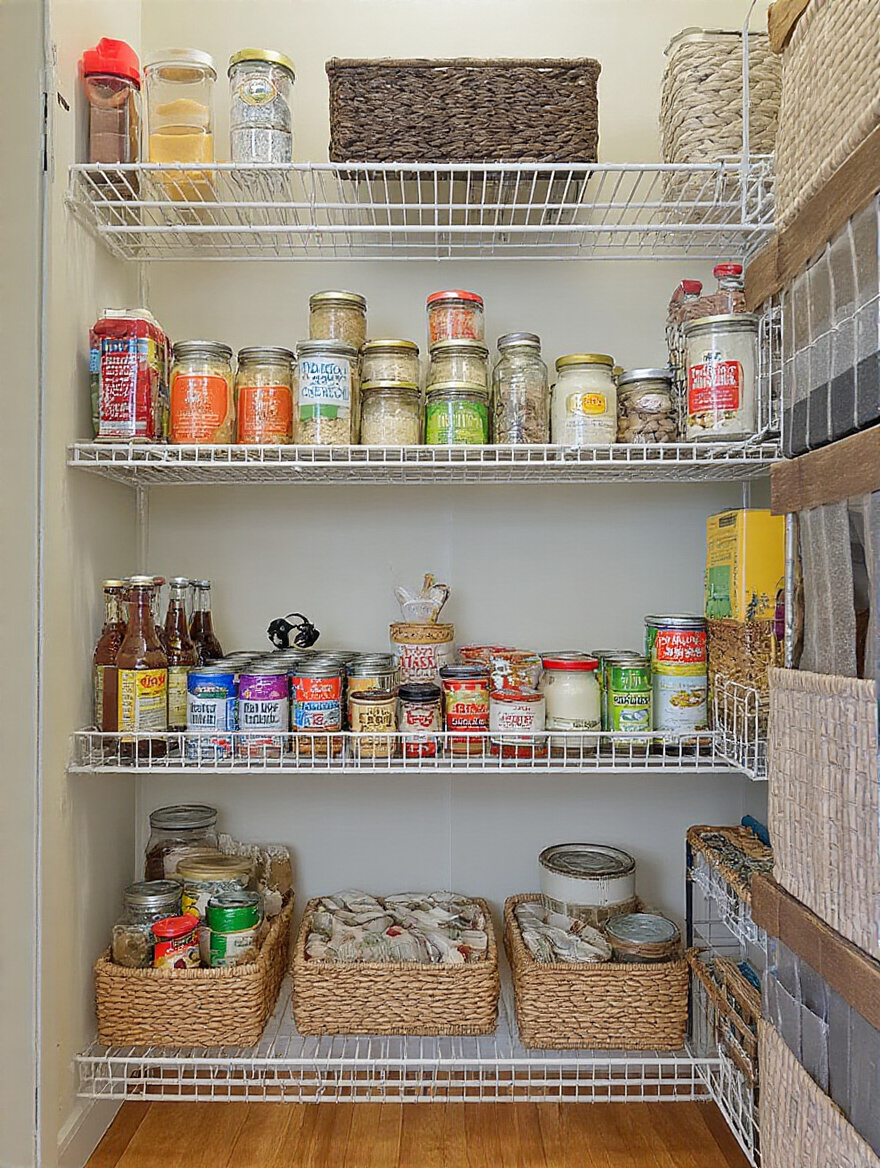
Empty every shelf. No cheating. Put it all on the dining table and get ruthless. If it’s expired, it’s compost. If it’s unopened and you know in your heart you’re not going to use it, donate it. Don’t let guilt about wasting food cause you to… well, waste food by letting it expire in your pantry. Create a “use it now” box on your counter for anything that’s nearing its date. Suddenly, you’ll see what you actually have, and your next grocery trip will be half the size.
This simple act connects you back to the cycles of consumption. It’s a small, tangible way to reduce waste and bring some intention back into what you buy and eat, which is a principle that’s just as important in your kitchen as it is in a garden.
3. Create Clear Kitchen Zones: Optimize Workflow for Seamless Cooking
Stop thinking about your kitchen as one big room. It’s not. It’s a series of workstations, and when you start organizing it that way, everything changes. You don’t keep your shovel in the same spot as your pruning shears and your potting soil. Each task in a garden has its zone, and the kitchen is no different. You should have a prep zone, a cooking zone, a cleaning zone, and a plating/serving zone.
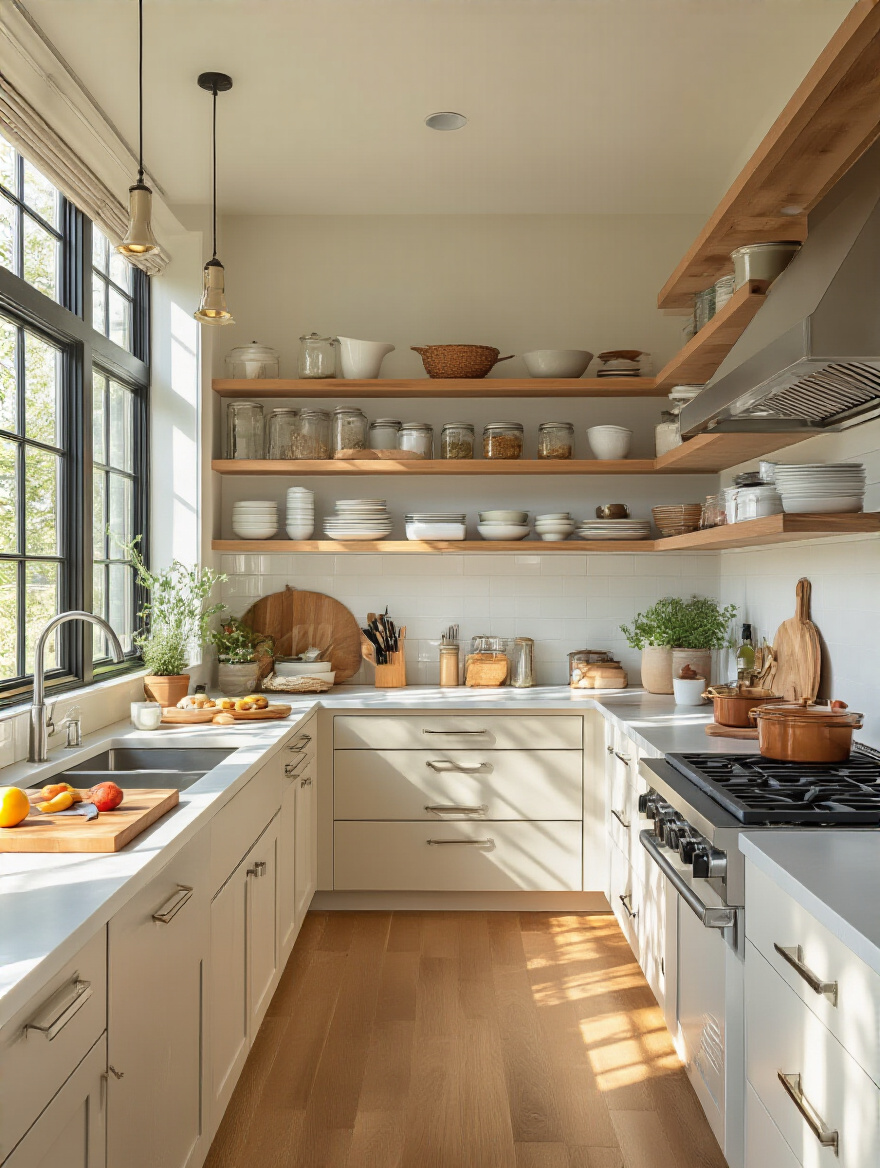
The “work triangle” of sink-fridge-stove is a decent start, but real life is more nuanced. I was designing an outdoor patio for a client who loved to entertain, and his biggest complaint was the constant back-and-forth. We re-organized his indoor kitchen to create a “serving zone” right by the back door—platters, big bowls, salad tongs, cloth napkins, everything. The chaos vanished overnight because we created a clear desire path from the kitchen to the patio. Store things where you use them, not where you think they “should” go.
By creating these zones, you stop scrambling and start flowing. You build efficiency into the very layout of the space, making cooking less of a chore and more of an intuitive dance.
4. Embrace the “Maybe” Box: Tame Transitional Clutter with Ease
You know those items. The weirdly-shaped serving dish your aunt gave you. The extra coffee maker you might need one day. These things can paralyze you during a declutter. You don’t want to keep them, but you feel guilty getting rid of them. The solution is simple: get a “maybe” box.
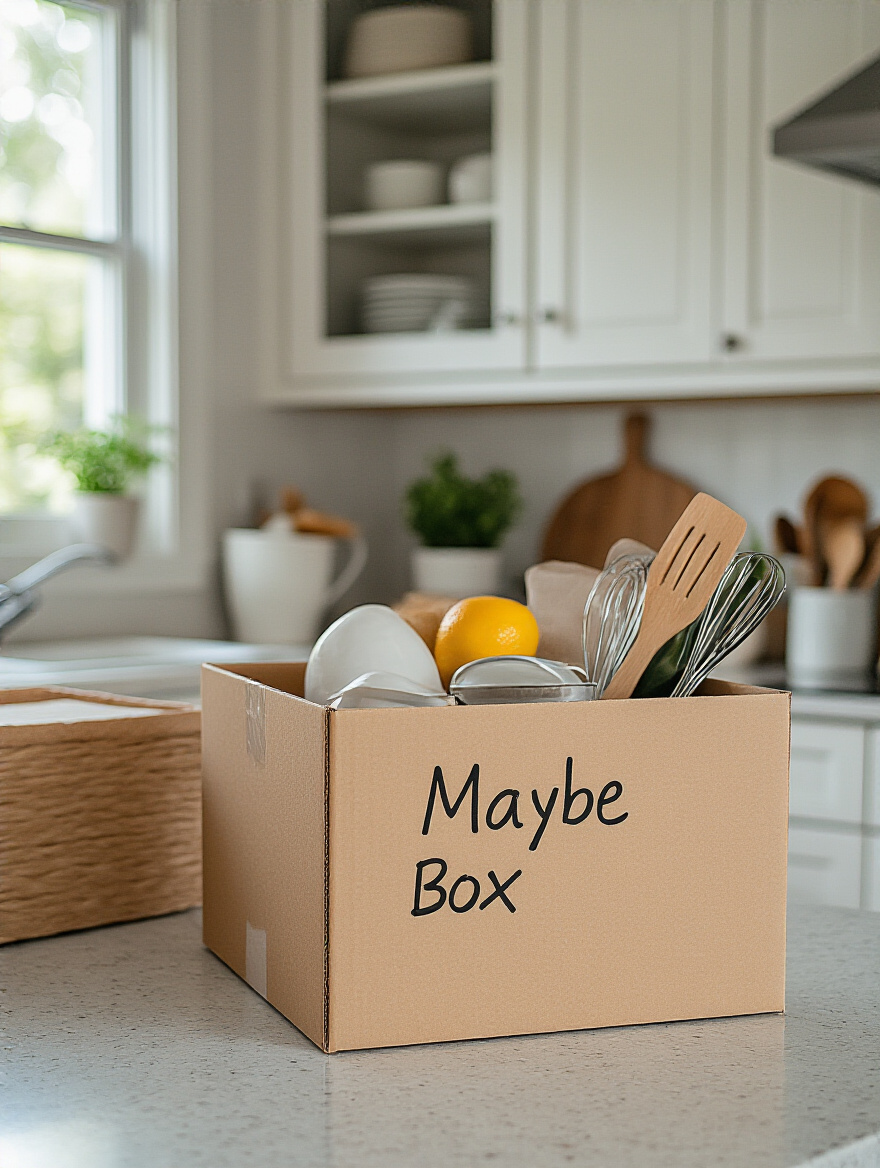
Think of it as a holding area or a quarantine zone. Put all those “I don’t know” items in a box, tape it up, and write the date on it. Stick it in the garage or a closet. If you haven’t opened that box in six months, you have your answer. You never needed that stuff. Take the whole box straight to a donation center. Don’t even look inside. It’s a guilt-free way to make a decision by, well, not making a decision right away.
This is the biggest shortcut I can give you for getting past the emotional hurdles of decluttering. It respects your sentimental attachment while still moving you toward the goal of a cleaner, more functional space.
5. Clear Your Countertops: Gain Daily Productivity and Visual Calm
Your countertops are the most valuable real estate in your home. They are your primary workspace. If they’re covered in mail, appliances, and random clutter, you have nowhere to work. A clear counter is the visual equivalent of a deep breath. It signals calm, order, and readiness. It’s like a freshly tilled garden bed, ready for you to create something.
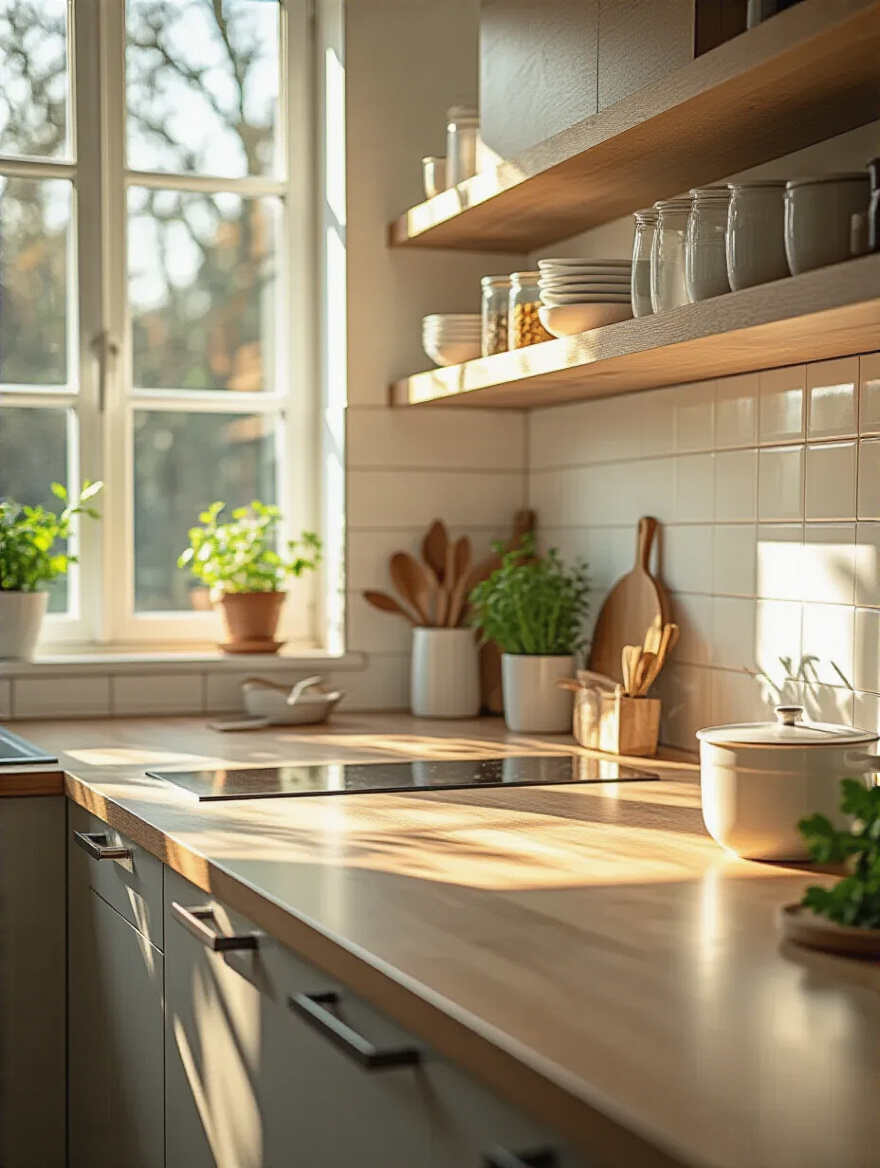
This is where everyone gets it wrong. They think the goal is just to have less stuff. No, the goal is to give everything that’s currently on your counter a home somewhere else. The mail gets a designated inbox by the door. The toaster goes in a cabinet if you only use it once a day. The knife block gets replaced by a magnetic strip on the wall. The only things that should live on your counter are items you use multiple times a day (like olive oil or a salt cellar) or things that are genuinely beautiful (like a bowl of fresh lemons).
I tell my clients to group the few essential counter items on a simple tray—a small slate slab or a wooden board works perfectly. It contains them visually and makes wiping down the counters a one-swipe job. This single habit, the “nightly reset” where you clear the counters, will do more for your sanity than almost anything else on this list.
With the ground cleared, you can now start planting the seeds of a truly functional system. Let’s move on to the structures that will support this new sense of order.
Mastering Storage: Smart Solutions for Every Nook and Cranny
Now we get to the fun part: finding clever ways to make your existing space work harder. This isn’t about buying a million plastic bins. It’s about looking at your cabinets and drawers with new eyes and using simple tools to unlock their hidden potential. Think of it as building trellises and raised beds—structures that help things grow in an orderly, productive way.
6. Install Vertical Shelf Dividers: Neatly Stack Plates & Bakeware
That cabinet with the leaning tower of baking sheets and cutting boards is a problem waiting to happen. Every time you need the one on the bottom, you risk an avalanche. The solution is so simple it feels like cheating: turn everything on its side. Storing flat things vertically is a game-changer.
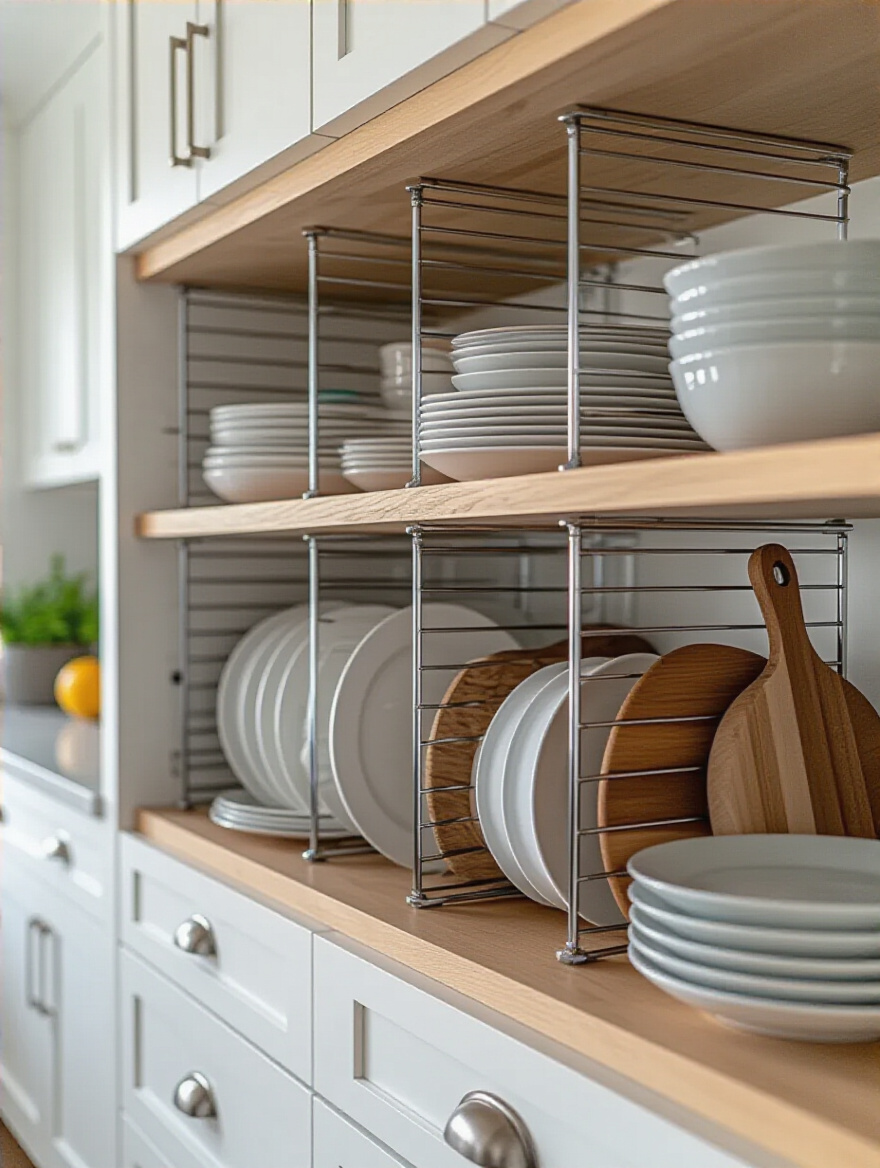
Simple tension-based or screw-in wire dividers create individual “files” for your bakeware, platters, and cutting boards. Now you can slide one out without disturbing the rest. It’s like a library for your cookware. You instantly reclaim all that wasted vertical air space in the cabinet and reduce the risk of chipping your favorite serving platter. It’s one of the most effective and low-cost upgrades you can make.
I once saw a client use these in a deep drawer for pot lids, and it was brilliant. No more frantic searching for the right lid while your pot is boiling over. Everything was standing at attention, ready to be deployed.
7. Utilize Pull-Out Cabinet Organizers: Access Deep Storage with Ease
Deep lower cabinets are fundamentally flawed. They’re black holes. The stuff at the back might as well be on the moon. The only way to make them truly functional is to make the contents come to you. Pull-out shelves and drawers are the answer. They transform those dark, unreachable voids into highly efficient, fully accessible storage.

Installing these is like bringing daylight into a dark corner of a garden. Suddenly, things can thrive. You can see the pot you need, the small appliance you forgot you owned. This is especially critical for heavy items like a stand mixer or a Dutch oven. No more kneeling on the floor and digging blindly. It makes the space more ergonomic and accessible for everyone, regardless of age or mobility.
Yes, they’re an investment, but the return in daily convenience and reduced frustration is enormous. If you can only do one major upgrade to your kitchen’s hardware, make it this.
8. Implement Tiered Spice Racks: Locate Any Seasoning in Seconds
Your spice cabinet shouldn’t be a guessing game. If you have to move ten jars to find the cumin, your system is broken. Tiered spice racks—the ones that look like little stadium bleachers for your spices—solve this instantly. They use the vertical space in your cabinet or drawer to make every single label visible.

When you can see everything you have at a glance, two things happen. First, you find what you need in seconds, which is crucial when you’re in the middle of a time-sensitive cooking step. Second, you stop buying duplicates. You’ll never again come home with a new jar of thyme only to find three others hiding in the back. That’s money back in your pocket and less waste.
A pro move is to decant your spices into uniform, square containers. They fit together more snugly than round jars, maximizing space, and you can put a label on the lid for drawer storage and on the side for cabinet storage.
9. Switch to Airtight Clear Containers: Keep Dry Goods Fresh & Visible
Think of your pantry as a greenhouse. You want to create the perfect environment for your food to stay fresh. The flimsy bags and boxes that flour, pasta, and cereal come in do a terrible job of that. They let in air and moisture and are an open invitation for pests. Switching to clear, airtight containers is a non-negotiable for a functional kitchen.
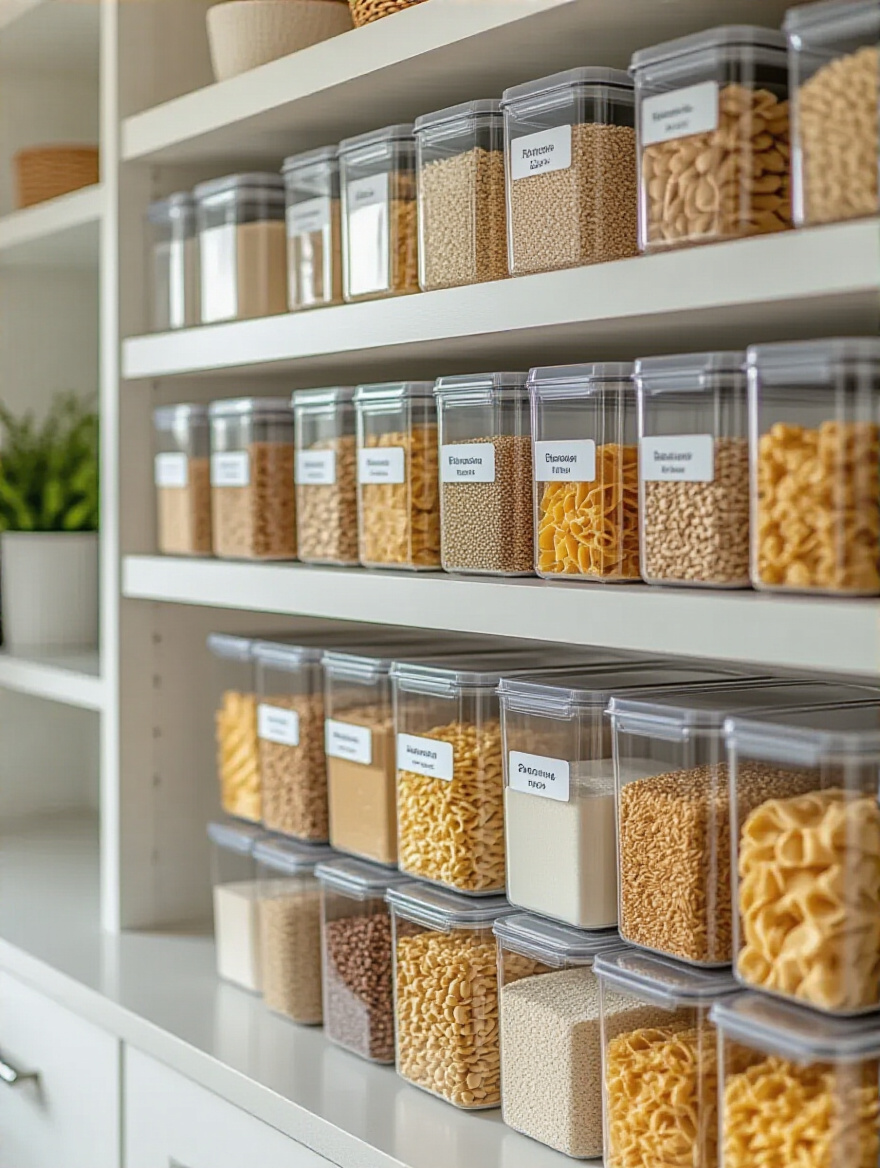
This isn’t about aesthetics, although it does look great. This is about food preservation and efficiency. When you can see exactly how much quinoa you have left, you know when to buy more. Your brown sugar won’t turn into a brick, and your crackers will stay crisp. You’ll reduce food waste dramatically because nothing gets lost or goes stale in a forgotten, half-open bag. It’s an investment that pays for itself.
When you transfer your goods, use a piece of masking tape on the bottom of the container to write down the expiration date. It’s a simple step that ensures you’re always using the freshest ingredients.
10. Mount Lid Organizers: Reclaim Valuable Drawer & Cabinet Space
The chaos of pot lids is a universal frustration. They are awkward, they don’t stack, and they take up way too much room. The solution is to get them out of your prime drawers and cabinets entirely. Use that wasted space on the inside of your cabinet doors or on a pantry wall.
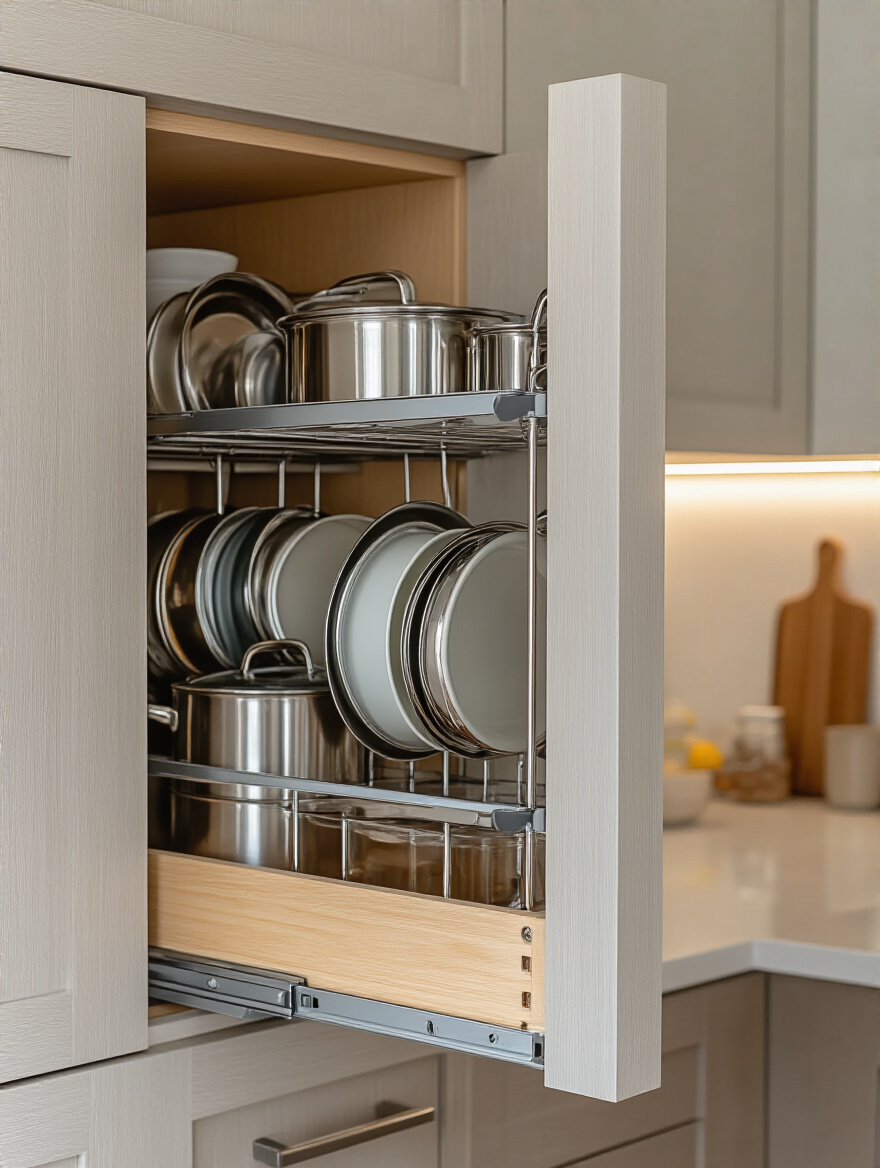
Simple, mounted lid racks hold each lid vertically, keeping them separate, visible, and out of the way. I’ve seen clients reclaim an entire deep drawer just by moving the lids to the cabinet doors. This creates more room for the pots and pans themselves, allowing you to nest them more easily without a jumble of lids getting in the way. It’s about leveraging those overlooked vertical surfaces to solve a horizontal space problem.
This one small change can have a ripple effect, allowing you to better organize your entire cookware collection and streamline the process of starting a meal.
11. Maximize Corner Cabinet Access: Spin & Store with Lazy Susans
Corner cabinets are the Bermuda Triangle of the kitchen. But they don’t have to be. A Lazy Susan, or a more advanced pull-out system, brings the contents of that deep, dark corner out into the light. No more getting on your hands and knees with a flashlight. With a simple spin, everything is front and center.
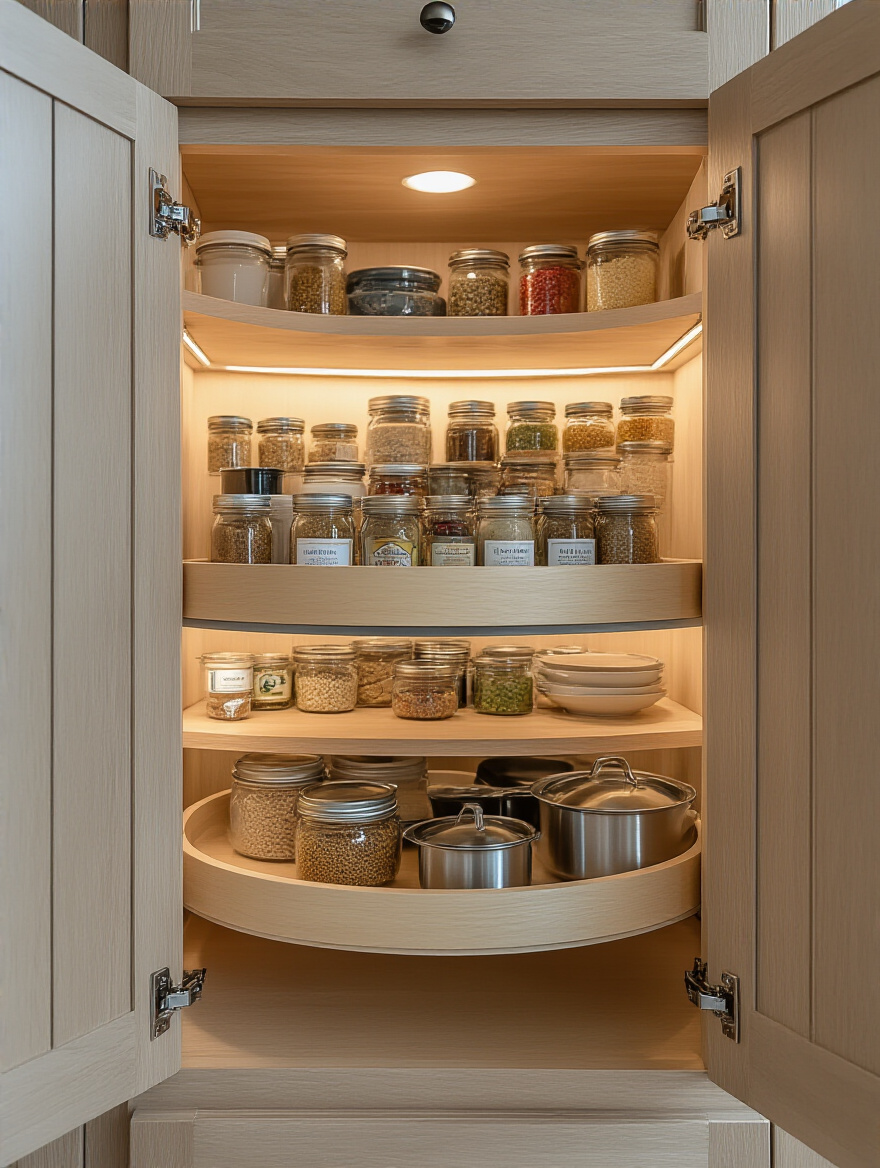
This is where I store things like oils, vinegars, and jars of sauce. Small bottles that would otherwise get lost in the back are always accessible. For a full corner cabinet, a multi-tiered unit can hold small appliances, mixing bowls, or even stacks of plates. It makes nearly 100% of that awkward space usable.
Think of it as crop rotation for your kitchen goods. Nothing sits in one place for too long, forgotten and unused. Everything gets its turn in the sun.
12. Use Under-Shelf Baskets: Add Instant Storage for Linens & Snacks
Look at any shelf in your pantry or cabinets. See all that empty air between the top of your stuff and the bottom of the shelf above it? That’s wasted space. Simple, slide-on under-shelf baskets are a genius way to capture it. They instantly create a new, shallow shelf where there was none before.
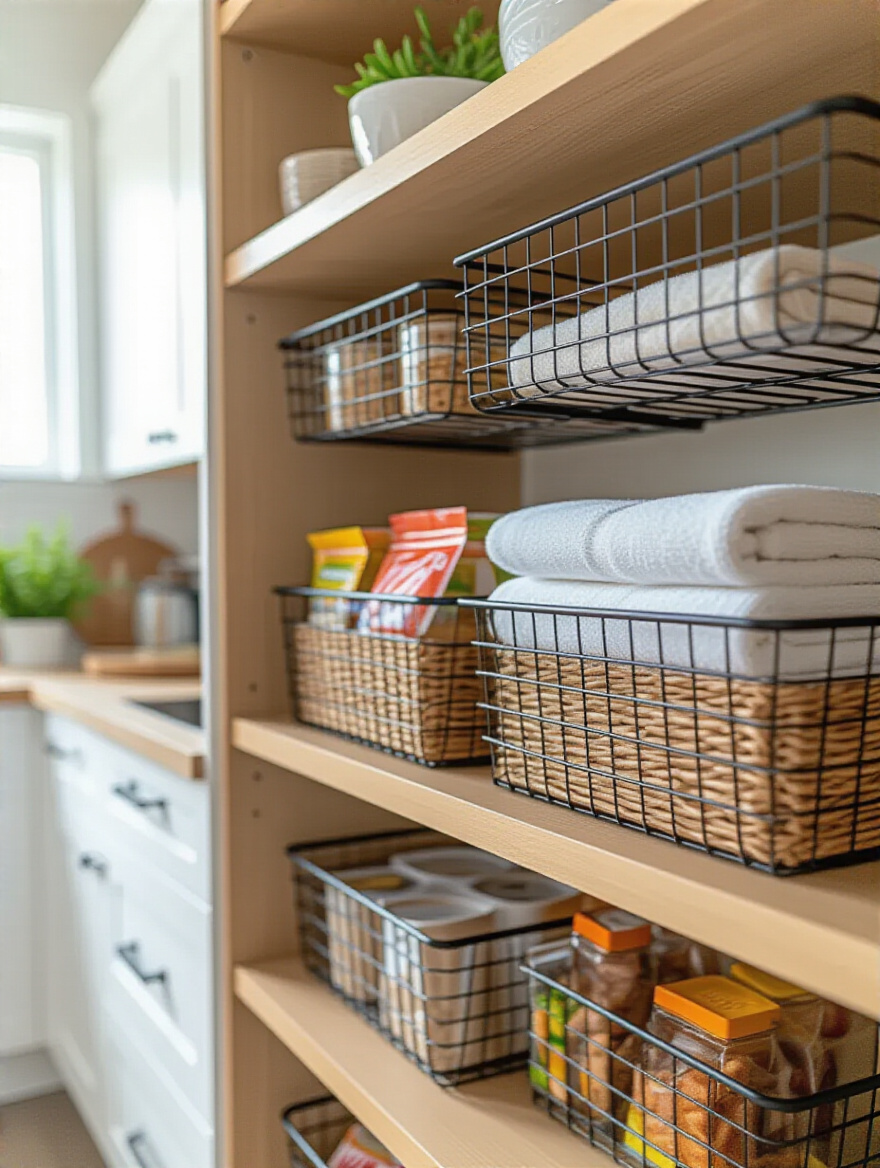
These are perfect for lightweight, hard-to-stack items. Think bags of chips, boxes of tea, kitchen towels, or sandwich bags. It gets them out of cluttered drawers and off your countertops. I particularly like using them for a “lunch packing” station in the pantry—bread, snack bags, and granola bars can all live in one easy-to-see spot.
It’s a small, inexpensive tool that solves a very common problem. It’s the definition of working smarter, not harder, with the space you already have.
13. Install Magnetic Knife Strips: Free Up Drawer Space and Enhance Safety
That clunky knife block on your counter is eating up valuable workspace. And tossing your good knives into a drawer is a cardinal sin—it’s dangerous for your fingers and dulls the blades. The solution that chefs have used forever is the best one: a wall-mounted magnetic knife strip.

It gets your knives off the counter and out of the drawer, putting them on display in a safe, organized, and accessible way. It frees up space and protects your investment in good cutlery. Plus, it allows the blades to air dry, which is more hygienic than the dark, damp slots of a traditional block.
Place it near your main prep area for the most efficient workflow. It’s a sleek, modern solution that signals you’re serious about cooking. Just be sure to invest in one with strong magnets; this is not the place to cheap out.
Now that we’ve built the right structures, let’s talk about how you move through the space. The best-organized kitchen in the world is useless if the workflow is clunky.
Streamlining Workflows: Creating Functional & Efficient Kitchen Zones
An organized kitchen isn’t static. It’s a dynamic space where you move and work. The goal here is to create clear pathways for your most common tasks. Think about the way a well-designed garden guides you from one area to the next. Your kitchen should do the same, making your daily rituals feel effortless.
14. Designate a Coffee/Tea Bar: Simplify Your Morning Routine
Your morning coffee or tea ritual should be a moment of calm, not a frantic scavenger hunt. If your mugs are in one cabinet, your coffee in the pantry, and your sugar across the room, you’re starting your day with unnecessary friction. Create one dedicated station for everything you need.

It can be a small nook on the counter, a section of your pantry, or even a small bar cart. But everything—the maker, the beans, the filters, the mugs, the sweeteners—lives in this one spot. You’ll be amazed at how much more pleasant your morning becomes when it’s a simple, one-stop process. This also declutters the rest of your kitchen, as all the related paraphernalia is contained.
A client of mine with a tiny city apartment used a simple rolling cart for this. It became his coffee station in the morning and a bar cart for entertaining in the evening. It’s about creating a dedicated, functional zone that adapts to the rhythm of your day.
15. Optimize Your “Mise en Place” Zone: Speed Up Meal Preparation
“Mise en place” is a fancy French term, but the idea is pure, simple wisdom: get everything ready before you start cooking. It’s the most significant thing you can do to go from a chaotic home cook to a calm, efficient one. Just like you’d gather all your seeds, tools, and amendments before you start planting a garden bed, you should prep all your ingredients before you turn on the stove.
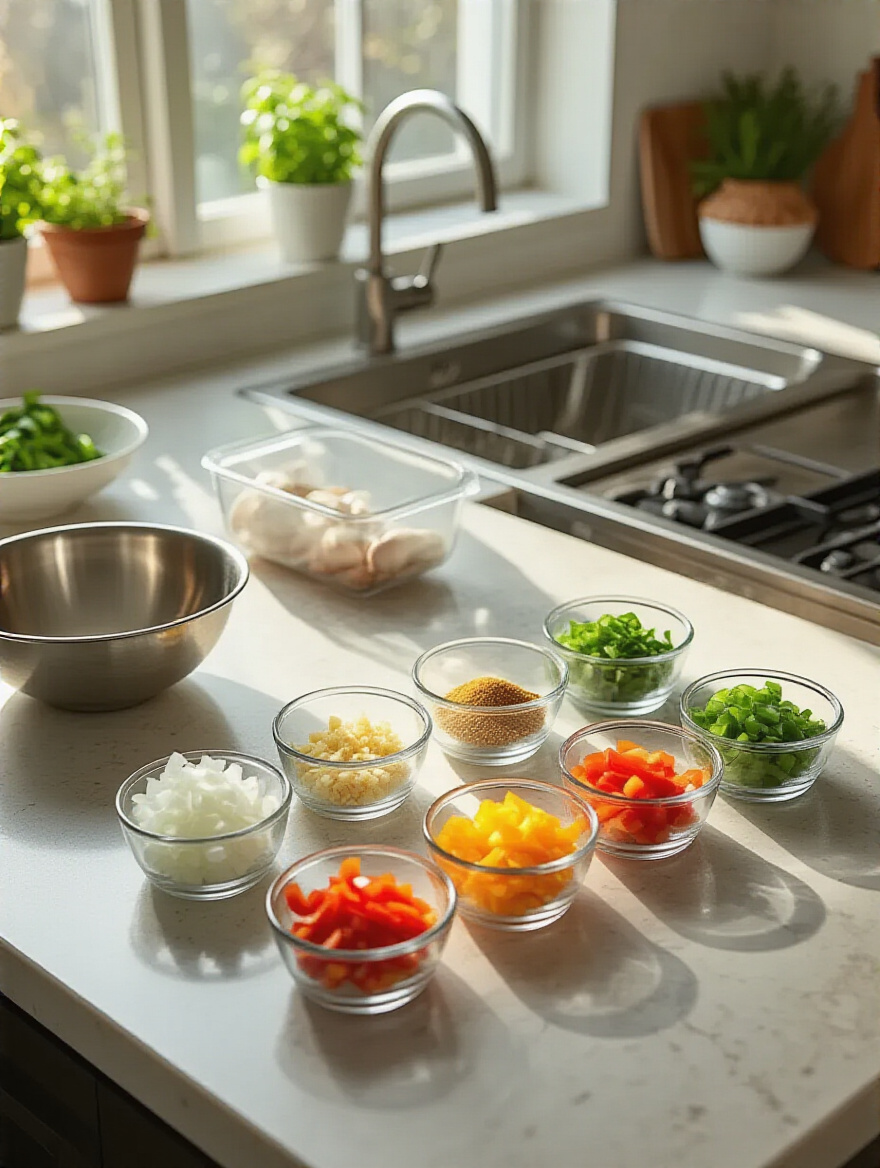
Designate a clear patch of counter space as your “mise en place” zone, ideally between your sink and your stove. This is where you do all your chopping, measuring, and organizing. Use small bowls to hold your prepped ingredients, and arrange them in the order you’ll use them.
When you work this way, cooking becomes a calm process of assembly, not a frantic race against the clock. You won’t burn the garlic while you’re frantically chopping an onion. You won’t realize you’re missing an ingredient halfway through. This single habit will change the way you cook forever.
16. Create a Grab-and-Go Snack Station: Empower Kids & Busy Adults
If you have kids, you know the constant refrain of “I’m hungry!” A dedicated snack station is the answer. It’s not about giving in to endless snacking; it’s about guiding them toward better choices and giving them independence. And let’s be honest, it’s just as useful for busy adults.
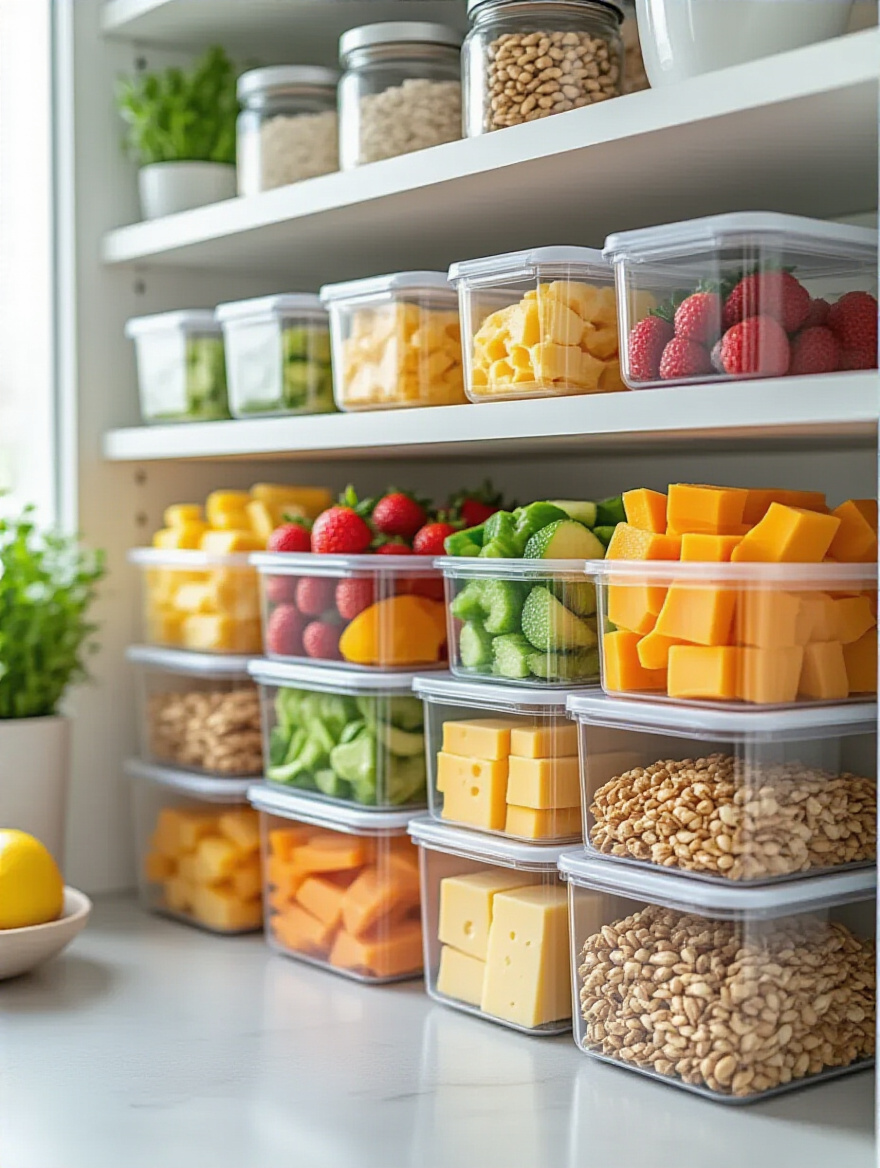
Designate a low shelf in the pantry or a drawer in the kitchen that’s easy to reach. Stock it with healthy, pre-portioned options: small bags of trail mix, fruit leather, cheese sticks, apple sauce pouches. When the options are clear, visible, and easy to grab, you’re “nudging” your family toward better habits. It’s behavioral science in action.
This system ends the negotiation and the constant searching. It also lets you see at a glance what needs restocking. For my family, we have a “snack bin” that we restock every Sunday. It takes 15 minutes and eliminates a whole category of daily stress.
17. Centralize Cleaning Supplies: Keep Dish Duty Efficient and Tidy
Just like your cooking zones, your cleaning zone needs to be optimized. Don’t keep the dish soap by the sink, the sponges under the counter, and the dishwasher pods in the pantry. All your cleaning supplies should live together in one consolidated spot, ideally right under the sink.
Use a simple caddy or a pull-out organizer to keep everything contained and accessible. This means when it’s time to clean up, you’re not on a mission to gather your tools. Everything is right there. This also keeps the clutter of half-empty bottles and wet sponges off your countertops, contributing to that sense of visual calm.
A great trick is to use a tension rod inside the under-sink cabinet to hang your spray bottles by their triggers. This frees up the floor of the cabinet for other supplies and is another example of using that overlooked vertical space.
18. Set Up a Recycling & Composting Hub: Reduce Waste Management Clutter
Waste happens. The key is to manage it gracefully. Having separate, overflowing bins for trash, recycling, and compost is an eyesore and a pain to deal with. The goal is to create a single, integrated hub for all your waste streams, preferably hidden away inside a cabinet.
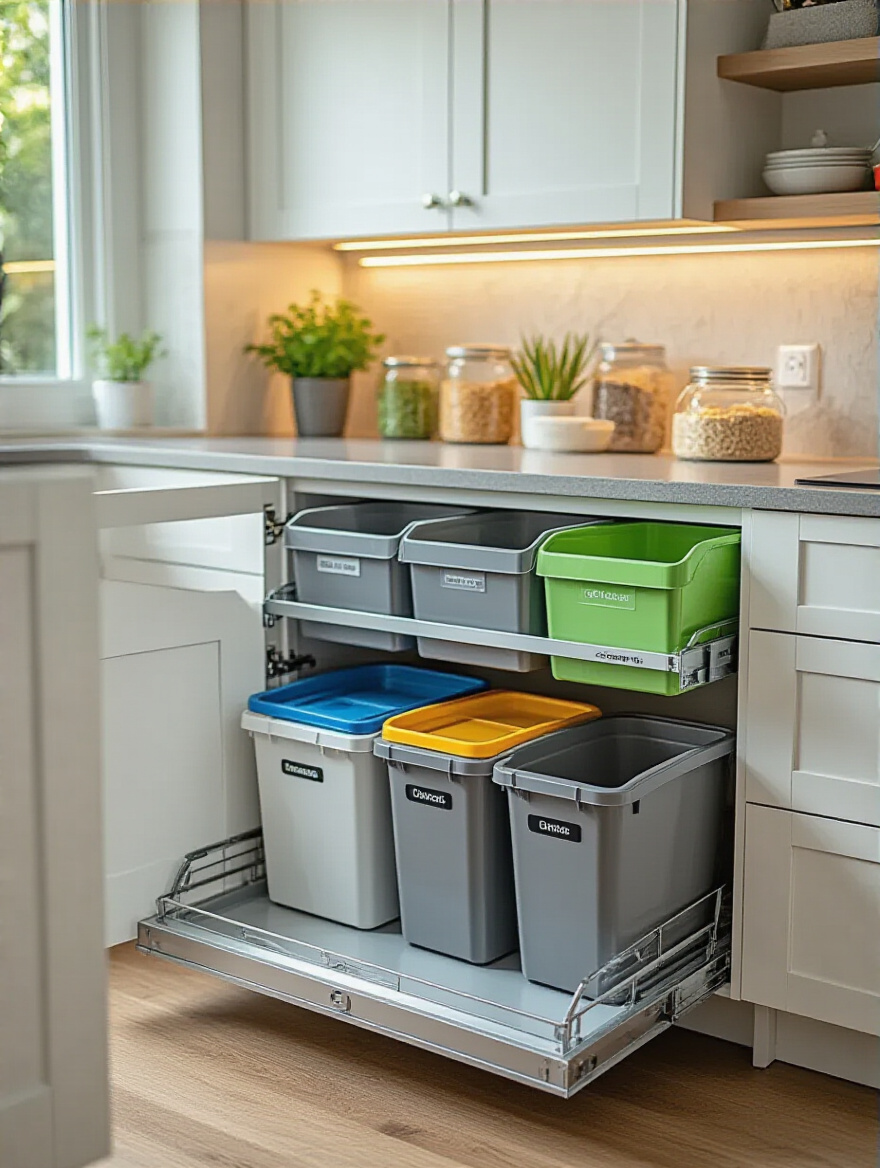
Many modern kitchens have pull-out bins designed for this, and they are worth their weight in gold. If you don’t have that, you can still retrofit a cabinet with a system of smaller, designated bins. The key is to make sorting and disposal as frictionless as possible. The easier it is to compost and recycle, the more likely you are to do it.
For compost, a small, sealed countertop pail is essential for daily scraps. You can then empty that into a larger collection bin outside or in the garage. By creating a smooth workflow for your waste, you make a sustainable practice a seamless part of your daily kitchen routine.
With the big systems in place, the final step is to build the small daily habits that make it all last.
Sustaining Order: Easy Maintenance & Lasting Habits
A garden, once planted, needs tending. An organized kitchen, once established, needs maintenance. This isn’t about more work; it’s about small, consistent actions that prevent the weeds of clutter from taking over again. This is how you make your new, functional kitchen a permanent reality.
19. Implement a 15-Minute Daily Kitchen Reset: Prevent Mess Overwhelm
This is the single most important habit for maintaining an organized kitchen. It’s not a deep clean. It’s a 15-minute sweep at the end of the day to put things back in order. Put on some music, set a timer, and get it done. Clear the counters, load the dishwasher, wipe down the sink, and put away any stray items.
Think of it as closing down the garden for the night. You put away your tools, coil the hose, and ensure everything is ready for the morning. Waking up to a clean, reset kitchen is a gift you give your future self. It removes all the friction from starting your day, whether you’re making coffee or packing lunches.
This small, consistent effort prevents small messes from turning into overwhelming projects. It keeps the baseline of your kitchen at “clean,” so you’re never starting from a major deficit.
20. Label Everything Clearly: Ensure Family Can Maintain Organization
Your beautiful new system is only as good as its ability to be used by everyone in the house. If you’re the only one who knows where everything goes, you’ve just made yourself the permanent kitchen gatekeeper. Labels are the answer. They are the silent communicators that keep your system running smoothly.

Use a simple label maker or even just masking tape and a marker. Label the shelves in your pantry (“Baking,” “Pasta & Grains”). Label the bins (“Snacks,” “Breakfast”). Label the containers in your fridge. This empowers everyone in the family to find things and, more importantly, put them away correctly.
I know it sounds a little obsessive, but I learned this the hard way on a big landscape project. We had hundreds of plants to install, and without clear labels on each batch, the crew would have been lost. Your kitchen is the same. Clear communication is the key to collaborative success. It’s the final step in turning your personal organization project into a sustainable household system.
Conclusion
So, there you have it. This isn’t just about tidying up. It’s about fundamentally redesigning the way your kitchen works so that it supports the life you want to live. It’s about removing the friction between your indoor and outdoor spaces, creating a natural flow that makes everything from making breakfast to hosting a backyard barbecue feel easier and more joyful. An organized kitchen gives you back time, saves you money, and reduces your daily stress. It’s the foundation for a home that truly nurtures you.
Don’t try to do it all at once. Like any good project, it starts with a single step. Pick one thing from this list that addresses your biggest pain point—that chaotic utensil drawer or the overflowing pantry shelf—and tackle it this weekend. Feel the immediate relief that comes from creating a little bit of order. Let that small victory fuel the next one. Slowly but surely, you’ll build a kitchen that isn’t just a room with appliances, but the true, functional, beating heart of your home.
